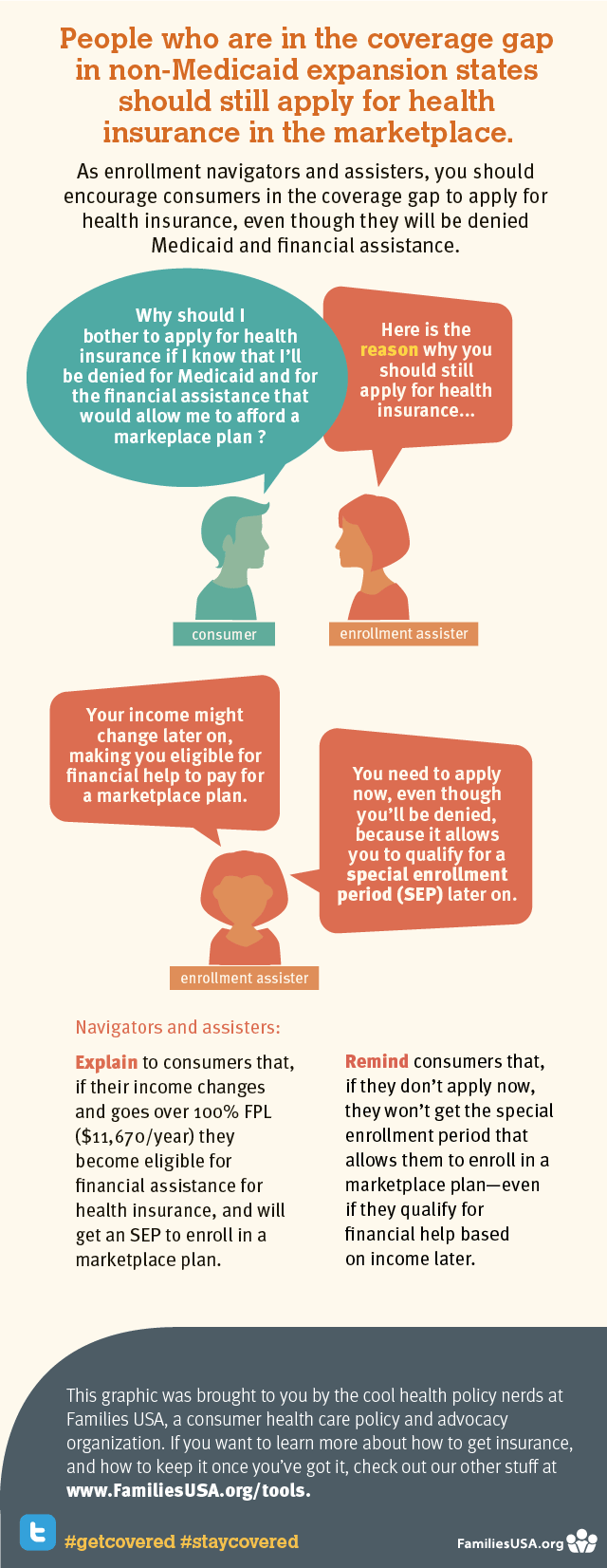
Why Assisters Should Encourage People to Apply for Health Coverage Even If They Fall in the Coverage Gap
11.11.2014
Updated December 15, 2014
Here’s an important reminder for enrollment assisters and navigators this open enrollment period and beyond: People who fall in the coverage gap should still apply for health insurance—even though they will be denied for Medicaid and for the financial assistance to help them with the cost of a marketplace plan. In this blog we explain why applying can be in the interest of consumers and why enrollment assisters should encourage all consumers to apply for coverage.
By applying for health insurance in the marketplace and being denied, consumers in the coverage gap preserve the opportunity to enroll in a marketplace plan with subsides if their income changes.
What is the coverage gap?
Twenty-three states have yet to accept federal funds to expand Medicaid, leaving nearly 5 million people in what is called the “coverage gap.” People in the coverage gap have no access to affordable health care: They make too much money to qualify for their state’s traditional Medicaid program, or don’t fall into their state’s eligibility groups, and they make too little to qualify for financial help (also called premium tax credits and cost-sharing subsides) to buy a private plan in the marketplace. A large portion of people caught in the coverage gap live in Southern states; in fact, a full 38 percent of those who fall into the gap live in Florida or Texas.
Why should someone still apply for insurance if they are in the coverage gap and will be denied?
People in the coverage gap are, by definition, ineligible for Medicaid and the financial assistance that would make a marketplace plan affordable. So, why should they apply simply to get a denial?
- They will ensure that if their income changes and rises above 100 percent of the federal poverty level and they become eligible for tax credits and cost-sharing subsidies to help them afford a marketplace plan, they will have a special enrollment period and be allowed to enroll in that plan.
Preserve the consumer’s special enrollment period rights
Officially applying for coverage is an important step for low-income people in states that are not expanding Medicaid. It will ensure that people in the coverage gap preserve their right to a special enrollment period (SEP) if their income later changes and they become eligible for financial assistance in the marketplace.
People in the coverage gap often have changing incomes. For example, their work shifts may change from month to month, or they may do seasonal work. If their income increases, they may become eligible for premium tax credits and cost-sharing subsidies that would make an otherwise unaffordable marketplace plan quite reasonable.
The Affordable Care Act provides sliding-scale tax credits for people with incomes between 100 and 400 percent of poverty. It also offers subsidies to reduce consumers’ out-of-pocket costs like out-of-pocket maximums, deductibles, and copays for people with incomes between 100 and 250 percent of poverty. If someone is in the coverage gap and his or her income rises above the 100 percent of poverty threshold, that person will become eligible to receive these premium tax credits and cost-sharing subsides.
However, in order to enroll in a health plan outside of open enrollment, an individual must qualify for a special enrollment period (SEP). To qualify for an SEP based on a change in income, that individual must already be enrolled in a marketplace plan or Medicaid. In most circumstances, this leaves people in the coverage gap out in the cold. But if people can show that they have applied for coverage and were denied because they fall into the gap, this will allow them to qualify for an SEP and enroll in a health plan with financial assistance. If they have not applied for coverage and their income rises above 100 percent of poverty, they will not be eligible to enroll in a marketplace plan, even though they are eligible for financial assistance.
Secure peace of mind by encouraging everyone to apply for health insurance
When enrollment assisters encourage everyone to apply for health insurance, they make sure that those consumers have options in the future—even if their application for help is denied. Additionally, some people may be eligible for the state’s traditional Medicaid program, while others may be eligible for premium tax credits and subsides to help with the cost of a marketplace plan. Many won’t know until they apply.
And while it is unfortunate for someone to find themselves in the coverage gap, applying for insurance to ensure they can sign up for a marketplace plan if their income changes offers some peace of mind.

